by Winding Pathways | May 24, 2018 | (Sub)Urban Homesteading, Flowers/Grasses, Foraging, Garden/Yard, Garden/Yard, Weeds
Years ago, a homeowner visited a garden store and bought plugs of a plant commercially called ground ivy, but most folks today call it Creeping Charlie.
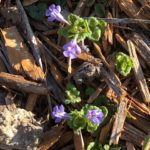
A great ground cover that can get away from you.
In many ways this exotic plant was an ideal ground cover. It’s tough, easy to transport and plant, adaptable to a wide range of conditions, needs no special care, and it spreads like crazy. It only grows a few inches tall so was touted as a plant that, once established, needs no maintenance. And, it attracts valuable pollinators early in the season before other flowering blooms appear.
Benefits
Creeping Charlie’s benefits are also its curse. It does everything too well. Creeping Charlie doesn’t creep. Rather, it races to cover a yard with astonishing speed, often crowding out more desirable plants.
There are two ways to view Creeping Charlie.
It’s either a pernicious pest or a friend that needs little care. At Winding Pathways, we look at it both ways depending on where it’s growing. When it’s crowding wildflowers or our garden vegetables we rip it out of the ground. In places where it can’t infect a garden or native wildflowers we leave it be and know we won’t need to mow that area often.
Controlling Creeping Charlie
There are lots of ways to control Creeping Charlie. We pull it out of the ground. Roundup and other herbicides kill it, and it’s possible to smother it under black plastic sheeting. Mulch works for a while but soon the plant will thrive on even a thick layer of shredded wood mulch.
A member of the mint family and also known more romantically by an elderly Irish friend as “Gill-Over-the-Ground”, Creeping Charlie is also edible steamed, added to omelets or brewed as a tea.
Other Ground Covers
We prefer ground covers that are less aggressive than Creeping Charlie. One of our favorites is the native Pussy Toes, which grows in patches in our lawn. We planted some when we moved in eight years ago and because we don’t put herbicides on our lawn it is spreading nicely. It is hardy and thrives in dry, sandy soil in baking sun. The hairy, silvery leaves lie close the ground and in spring send up enchanting stems with little “pussy toe” flowers. The Lady Bird Wildflower Center confirms this native plant is widely spread and thrives in open meadows and woodlands and rocky areas. We’ve seen it all over the eastern half of the country and Canada. We love it! Again, it saves mowing, adds color and texture to the landscape and attracts early season pollinators.
We also use Vinca, with its periwinkle flowers, on some parts of our lawn especially areas we do not want to mow. It spreads easily, adds color and texture to the landscape and reduces maintenance.
-
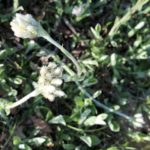
-
Pollinators like ants flock to pussytoes.
-
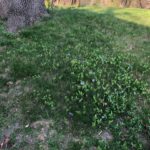
-
An excellent ground cover.
-
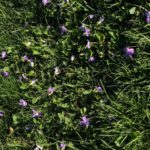
-
Pretty purple violets.
Our lawn actually is a mosaic of many plants. Since we shun herbicides we have a lawn blend of grasses, violets, dandelions, pussytoes, and many other plants. They are all fascinating and help pollinators through the seasons.
by Winding Pathways | May 17, 2018 | Bugs, Garden/Yard, Nature, Pests
Creepy Crawlers
Even before Lyme disease created a serious tick-borne health hazard no one wanted ticks crawling on them. We sure don’t want them at Winding Pathways and because our yard has tall grass, shrubs, and a woodland we have tick habitat.
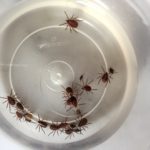
Collection of ticks
A few years ago, Rich contracted Lyme Disease caused when a tick injected bacterium into him. Thanks to a wise physician and effective antibiotics he was cured, but it’s possible to get Lyme Disease again and again. We’re more cautious about avoiding ticks now.
Ticks of many species live throughout most of the United States. They’re common in brushy, grassy, and woodsy habitat but they also love living in yards. It’s possible for a tick to enjoy a human meal even if that person never leaves a mowed yard.
Natural Tick Predators
Although naturalized yards are sometimes good tick habitat they also attract tick predators that love to snack on the tiny invertebrates. Many small birds, including warblers, wrens, and brown creepers among them quickly convert any tick they find into lunch.
Possums Are Us!
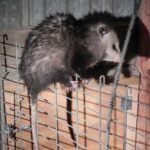
Opossums groom themselves carefully.
A newly understood tick-lover is the common opossum. Many people consider this ancient marsupial a homely animal and would prefer to not have one in their yard, but they might want to rethink this. According to the Carey Institute, opossums are tick vacuum cleaners. As they walk through a yard ticks hitch a ride, thinking they will be able to burrow into the animal’s skin and feast on warm blood. The tick doesn’t realize that possums groom their fur often and comb out ticks. These are readily eaten by the always hungry mammal. Having an opossum in the neighborhood can reduce tick numbers.
Foxes and Coyotes
Small predators, like the fox, are also valuable in tick reduction. According to a study by Dr. Hofmeester, Foxes and coyotes eat mice that ticks feed on. Ticks need three meals before they can reproduce, so more foxes and coyotes can reduce the mouse population and thus, the tick population by “…breaking the cycle of infection.”
Life Cycle
Tick numbers are also associated with climate change and abundance of food. Dr. William H. Schlesinger in an April 2018 issue of Citizen Scientist wrote about the work of Rick Ostfeld with the Carey Institute. The occurrence of ticks one year relates to mice numbers the year before, which relates to food abundance in previous years. The chain of life! And, according to Ostfeld, white-tailed deer are less implicated, unlike initial beliefs, and turkeys also appear to help reduce tick numbers. That is great news for us at Winding Pathway because the wild turkeys pretty much take over our yard at times!
Gobbling Guineas
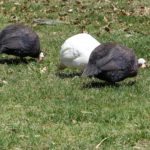
Guineas eat ticks.
A domestic bird that loves ticks is Guineas. They are tick lovers. They are African natives that have been domesticated. Elise Gallet de St Aurin, of Cheshire Moon Farms, told us the guineas that roam her farm near Atkins, Iowa, keep it clear of ticks. These attractive but loud animals roam widely, roost in trees, and eat all sorts of invertebrates, including ticks.
It’s impossible to buy or confine an opossum. But, guinea chicks can be ordered from Hoover’s Hatchery. Some people also enjoy eating guineas.
Repelling Ticks
A simple way to reduce odds that a tick will hitchhike on a person is to use repellents and chemicals that kill them. Any insect repellent containing DEET will repel ticks. Spray it heavily on the legs and arms and on clothing, especially pant legs, shoes, and socks. DEET doesn’t persist long and disappears after clothes are washed so it needs to be reapplied often.
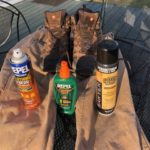
Various forms of tick repellent.
A more permanent solution is to use a spray containing permethrin. This chemical actually kills the ticks. It lasts a long time, even through several wash cycles. It should not be applied to the skin. We spray it on our pants, socks, and shoes. One set of Permethrin-sprayed-pants remains hung in our cabin – not in the house – to put on when we are venturing in likely tick habitat.
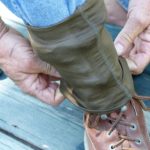
Protect yourself with gaiters
Ticks usually access a person from down near the ground. They’re most likely to cling to pant legs or socks and then walk uphill on the skin. Tucking pants into socks makes life harder for these pesky animals, and we take it one step further. We bought a pair of tick gaiters from Forestry Suppliers, Inc. They cost about $11 and fit over shoes and pant legs, forming a tight seal.
Tick Checks
Doing a “tick check” is important. After being outside take a hot sudsy shower and check the body over for ticks. Fortunately, they usually wander around on the skin for several hours before burrowing in. A tick that has not penetrated the skin won’t spread disease and often is simply washed down the drain. Launder the clothes right away.
Ticks deserve respect. They can spread serious disease and they lurk where people often go. Don’t let a fear of ticks keep you inside. Go outside and play but take precautions to reduce the chances of catching a tick-borne illness.
by Winding Pathways | Apr 19, 2018 | Chickens, Garden/Yard, Garden/Yard
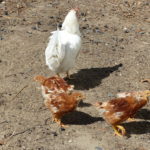
Mama Hen with chicks foraging.
Now a couple of months old, the quartet of chicks is exploring farther afield. After the cold and snowy introduction to the outside world in late March, they readily follow Mama Hen outside.
Mama protects them inside from the other hens by cornering the chicks and standing literally in front of them, screening them from the others who get too close. Outside, Mama clucks and calls the chicks over for food and again, warns off the adults with a serious sounding tone and lunge toward one that may get too close to the chicks or be aggressive toward them.
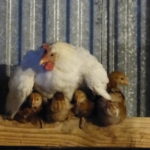
Mama hen with four chicks on roost.
The chicks learned how to fly up onto the roost with Mama and she mightily shelters them at night. We were worried the first few nights in April when temperatures fell to 11 degrees. But, they did OK.
Getting back down off the high perch is a challenge. A hilarious video shows three on the ground foraging and one walking back and forth screwing up courage for the long “flight” down.
The other day, one chick squeezed through the wire into the yard. Mama called it back. The funny thing about chickens is they can figure out how to get out and sometimes cannot figure out how to get back in.
Enjoy our blogs, pix and videos of the chicks growing up.
by Winding Pathways | Apr 12, 2018 | (Sub)Urban Homesteading, Chickens, Foraging, Garden/Yard, Geology/Weather
You know Steve Brown is from Texas right away. Vernon, Texas, to be exact. Home of the Red River Valley Museum, that features native sons trombonist and singer, Jack Teagarden and singer-songwriter, Roy Orbison. Brown’s drawl and easy manner draw you in. But, there is something else in his voice – maybe a hint of an Eastern clip? Perhaps a touch of wry Midwestern humor? And, what about the creative way he describes raises chickens in the north?
Technology and Tinkering
All of these are part of Dr. Stephen Brown who has lived, studied and worked in Upstate New York, Kansas, and now Alaska. “I grew up raising chickens since age eight,” he stated. “I love the soap opera of the coop,” he added. An engineer and self-professed “tinkerer” Brown is smart, innovative and ambitious. Above all, he is good with people. Pretty important qualities since he is District Agriculture and Natural Resources Cooperative Extension Service Agent for the Mat-Su/Copper River District of Alaska. He integrates his specialties of Global Positioning System (GPS) and Geographic Information Systems (GIS) with agriculture and the environment.
He applies his advanced degrees in Environmental Sciences from the University of Texas at San Antonio and the State University of New York, and his numerous publications and presentations practically for those living in the far north.
As Alaskans learn to raise poultry, till the soil, and ward off predators Brown is right with them. “I get to remote homesteads by boat, airplane and snow machine,” he said. “I may be the only extension agent in the country with reimbursement mileage for a snow machine,” he quipped.
Adapting the Coop
“Chickens can adapt to the cold when they have a safe coop,” explained Brown. After arriving in Alaska about a dozen years ago, he experienced some of the challenges of “high latitude farming.” He researched and presented keynote talks across the US and Canada. Then, he adapted methods that fit with homesteader lifestyles and pocketbooks. “You have to be practical because of the costs,” he explained. For example, temperature extremes make watering farm animals a problem. Since you don’t want to haul fresh water out every day and everything in Alaska is expensive, Brown adapted dog water bowls to stay heated in the winter for the low cost of about 15 bucks.
Brown also addressed other barriers to raising poultry in the far north. “Frostbite and ammonia build up are the two largest killers up here,” he explained. To prevent frostbite on chickens’ toes, Brown simply installed flat perches instead of round ones, so the chickens’ feathers covered their toes when they roost. Frostbite solved.
Animals also need to be safe from predators – bears and mosquitoes. So, the coop must be sturdy, have mosquito netting inside heavily wired windows, and have good ventilation. He converted an old horse stall to a secure, ventilated and warm chicken coop. He affirmed that chickens can handle the cold and only adds a heat lamp when temperatures really drop into the double-digit minus degrees.
Tom Sawyer Method
The deep litter method works well to keep the coop fresh and prevent ammonia build up. Spread a thin layer of fresh litter about once a week and toss in some treats for the chickens to scratch and keep the litter turned over. A couple of times a year he uses the “Tom Sawyer” method of cleaning up the coop. “I invite local gardeners to come over to my place twice a year and clean out the deep litter. I show them how to use it in their gardens to improve their soil for better crops,” he explained. Win-win.
Some poultry techniques he teaches in “Chicken U” classes which fill up. These include such basics as how to safely catch, hold, and butcher a chicken. Classes are booming and so is poultry husbandry. According to Brown, in the past eight years, chicken orders have skyrocketed from single thousands to well over 120,000. He gets to experience the great results of good husbandry and farming in part because he is president of the Alaska State Fair board of directors. The State Fair runs late August.
Marathon Man and Mountaineer
In his position, Brown is passionate about more than chickens. He has been on the cutting edge of promoting Rhodiola rosea as an important cash crop for Alaskans.
And, he is not all work and no play. His recreational pursuits run deeply, too – literally. He’s a marathoner and mountaineer. Since 1979 Brown has summited numerous peaks and seeks to summit on all continents. He even mused about taking a chicken to the top of Denali. “Even though I am no a spring chicken myself, I think it’d be kinda fun,” he said.
Call him up some time to chat chickens and crops. You’ll know him at the Alaska State Fair by his drawl and friendly manner that draws you in.
by Winding Pathways | Apr 5, 2018 | (Sub)Urban Homesteading, Chickens, Garden/Yard
It may seem odd for a bird that evolved in tropical Southeast Asia to thrive up in the frigid north but increasing numbers of people are enjoying the benefits of backyard chickens in Canada, Maine, Michigan’s Upper Peninsula, in Northern Minnesota, and even Alaska.
Although, chickens are hardy and adaptable, raising them way up north requires special management. Among the challenges both chickens and their owners face is frigid temperatures, vastly different day lengths between winter and summer, and the sometimes difficulty of buying feed and supplies in areas far from where chicken culture is common.
Steve Brown, extension agent for the University of Alaska Fairbanks Cooperative Extension office, Palmer, AK, has been advocating chicken husbandry in Alaska for many years. He has a flock and regularly helps others acquire and manage birds. It’s challenging but the rewards are many.
Frigid Temperatures
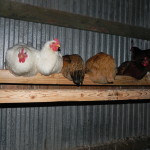
Chickens sheltered from the cold.
Everyone knows Alaska is a cold place, so during the long winter hens need a coop that protects them from the wind and predators and moderates the temperature some. Moisture causes chicken manure in litter to quickly generate ammonia so keeping the coop dry is important. Brown uses the deep litter method to keep the coop floor dry and only occasionally warms his coop when temperatures drop really low.
Daylight
Chickens are daytime creatures and in southern Alaska there’s upwards of 17 hours of darkness in the winter. “LED bulbs solve the lighting problem and keep expenses down. Electricity is expensive here, and LED bulbs provide great light while consuming little energy, keeping my costs down,” said Brown. During warm seasons he lets his chickens forage in the yard and also uses a chicken tractor.
Supplies
Nearly all food is shipped to the state, so finding fresh eggs is challenging, but Steve and many others enjoy eggs that come directly from the coop. Fresh eggs sell for $8 a dozen!
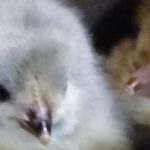
Chicks can successfully be shipped to the cold north.
But, where do the chicks come from? “I buy chicks from a company in Texas. They airmail them to me and they arrive in good shape. Usually I buy about 100 chicks, raise them for several weeks and sell most of them to other families who want chickens using Alaskas List, like Craig’s List. I keep a small flock at my home,” he said.
Feed and supplies are hard to come by in Alaska and expensive. “I don’t buy grit but collect sand and small pebbles from a nearby river bank, and I feed my chickens a lot of kitchen scraps, dog food, and fish scraps. Sometimes fishy taste gets into the eggs,” he said.
Brown sticks with hardy brown egg laying breeds which stand the cold better than Leghorns. “I like Chanteclers, Rhode Island Reds, Plymouth Rocks, and Orpingtons,” he said.
Continental Climate Chickens
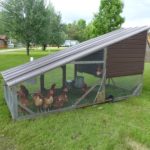
Chicken Tractor
Another family that raises far north chickens is Paul and Karen Colson. They probably raise the most northern flock in the contiguous United States. They live in Minnesota’s Northwest Angle. The Angle is a relatively small area bounded by the Lake of the Woods and Manitoba. To reach it, a driver must enter Canada, drive NE about 40 miles, and then reenter this remote part of the United States. Like Alaska, nearly all supplies must be hauled in a long distance.
The Colsons raise broilers and keep a small flock of laying hens. Although not as far north as Alaska they face the same challenges of cold, day length, access to supplies, and predators as Brown does and manage their chickens in a similar way.
No place is really too far north to keep chickens. It takes more time and work to keep hens healthy in a harsh climate but the fresh eggs and meat they provide make it worthwhile.
by Winding Pathways | Feb 22, 2018 | (Sub)Urban Homesteading, Garden/Yard, Mammals
Moles in winter? You bet! We were amused and amazed to look out our den window and see a heaped-up line of topsoil on top of several stepping stones. Even in Winter, our moles are active!
Many people hate moles because their tunneling raises mini ridges in the lawn and their hills smother a patch of grass and get
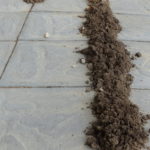
Moles bring rich dirt from below to the surface as they tunnel along hunting for earthworms and grubs.
caught in a lawnmower’s blades. Some go to great lengths to poison or kill moles.
How Moles Are Helpful
We don’t. They’re amazing animals that provide us with a wonderful service. Their endless digging in search of earthworm and insect meals softens the soil, enabling water to easily percolate in and helping plants grow. The greenest grass of the lawn always seems to be where moles tunneled last year.
Instead of persecuting our moles we simply stomp down the raised tunnels and rake out the mole hill before mowing, and then we quietly thank our subterranean helpers before starting up the lawnmower.
Moles are active all year but the frozen ground is daunting for them. Our January moles were tunneling in the soft unfrozen soil on the south side of the house and under dark stones that catch the sun’s heat and keep the ground underneath them unfrozen. We hope they found some grubs and worms for dinner.
We’re happy to share our yard with moles and appreciate the positive impact they have on the soil. Watch this YouTube Video about moles.















